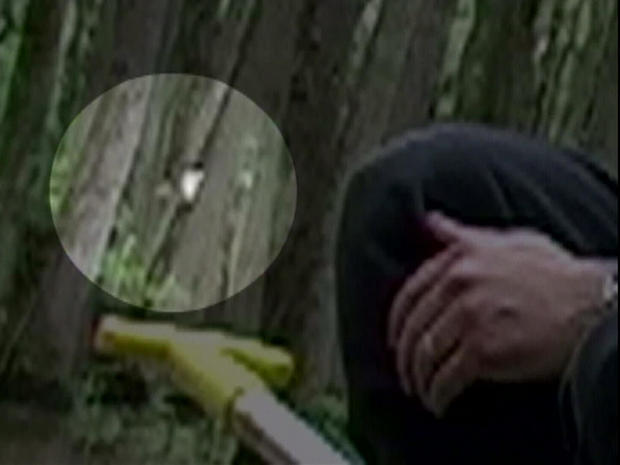The return of "extinct" species
Seventeen years ago, while floating through this spooky swamp in Arkansas, Tim Gallagher and Bobby Harrison saw a ghost. "Neither one of us knew what we were looking at," said Harrison. "And we've been birding all our lives. It turned up on edge. And you could see those white trailing edges of the wing."
"That's when you knew?" asked correspondent Conor Knighton.
"Just locked in. We were both locked in," Gallagher said.
"We both yelled, 'Ivory-Bill!'" Harrison laughed.
The Ivory-Billed Woodpecker was thought to be totally extinct. Gone. Dead forever. The last good film of one was taken back in the 1930s. And yet, Gallagher and Harrison were sure that was the bird they'd seen.
Even now when he thinks about it, Harrison said he gets "real emotional."
The men had traveled to Arkansas after kayaker Gene Sparling reported seeing an Ivory Bill in the same spot a few days earlier. Once Gallagher saw one with his own eyes, he convinced his colleagues at Cornell University to conduct a massive search, a search that eventually led to a bit of blurry video.
That out-of-focus footage was enough to set off a media firestorm. "60 Minutes" did a feature on the rediscovery. "Sunday Morning" sent Steve Hartman down to Arkansas to get an ivory-billed haircut.
The bird was back!
At an April 2005 press conference Interior Secretary Gale Norton said, "I cannot think of a single time we have ever found a species, once thought extinct, and now found to be in existence."
But it turns out the rediscovery of an allegedly "extinct" creature actually happens more often than you might guess. While species are disappearing at an unprecedented rate, a handful have reappeared. Animals mistakenly thought to have been killed off, like the Bavarian pine vole, and the Lord Howe Island Stick Insect, are all known as "Lazarus taxon." In the Bible, Lazarus came back from the dead.
"When you declare something extinct, that's almost like a challenge to people: 'Okay, we're now going to go and find this thing, prove you wrong,'" said Craig Hilton-Taylor, who is in charge of the International Union for Conservation of Nature's "Red List," the most comprehensive species status list in the world. With categories ranging from "Least Concern" to "Vulnerable" to "Critically Endangered" to "Extinct," it's that last category that's always hardest to pin down.
"Trying to determine that fact is really, really hard to actually know when that final individual has disappeared," Hilton-Taylor said.
"Yeah, it seems like endangered, there's a range; extinct is very binary. You're either extinct or you're not," said Knighton.
"It is very binary, exactly. Yes, it's there or not. And it requires lots of gathering of evidence – negative evidence – over a long period of time."
Ultimately, extinction ends up being an educated guess. We're pretty confident Stegosauruses aren't still running around Colorado. But when it comes to smaller, more elusive creatures, well …
"There's a big world out there, and there are a lot of places to hide," said biologist Forrest Galante, who has made a career out of searching for these "lost" species. Each episode of his Animal Planet show "Extinct or Alive" focuses on a creature presumed to be long gone. While most episodes end without concrete proof of an animal's existence, in the Galapagos Islands, a promising piece of poop led Galante and local experts to the rediscovery of the Fernandina giant tortoise.
"To hold this 'extinct' species that the world hadn't seen for 114 years, like, I'm still not sure if it's real," Galante said. "I think it might've been a dream to this day. Like, I can't believe that we found this thing!"
Modern technology has made searching for species easier. But discovering evidence of an extinct animal doesn't always involve mounting an expensive international expedition, with drones. Sometimes you need look no further than your own back yard.
In 1981, a dog belonging to Meeteetse, Wyoming rancher John Hogg dragged home a supposedly extinct Black-footed Ferret. Kimberly Fraser said, "Here was this animal, dead on his back porch. And he picked it up, and he looked at it, and he didn't know what it was."
When John's wife, Lucille, wanted to get it stuffed, their taxidermist realized it was something special.
"And how fortuitous. What a great story! What a chance to bring a species back from the brink of extinction," Fraser said.
Fraser works with the Black-footed Ferret Recovery Program. Thanks to that one dead ferret on a porch, scientists discovered a tiny group of them still alive in Wyoming. They were rounded up and put in captive breeding programs. Thousands of Black-footed Ferrets have been released back into the wild.
Fraser said, "I think it's a great example of people coming together and doing the right thing. We definitely have hope, hope for the future."
We are in the middle of a human-caused extinction crisis. Reintroducing a species is a rare chance to right a past wrong.
Back in the swamps of Arkansas, it's been over a decade-and-a-half since Tim Gallagher's Ivory-billed Woodpecker sighting. He said he has not seen one since.
Despite all of the initial excitement, the woodpeckers have remained elusive. Stylist Penny Childs still holds onto her collection of memorabilia, although it's been ages since anyone has asked her for a woodpecker haircut. "Once the word broke, then everybody came," Childs said. "And if he was there, goodnight, you know? I woulda left, too! I mean, the woods was just crawling with people. I mean, it was just crazy."
Maybe the woodpecker got scared and flew the coop. Maybe Gallagher and Harrison saw the very last one. Maybe they were mistaken, and didn't see one at all.
But the men have come back to search together dozens of times. It's all on their own dime now; nobody is paying for this quest.
They feel an indisputable sighting of an Ivory-billed Woodpecker – a crystal-clear picture – would mean more than bragging rights. It could lead to habitat conservation that would help revitalize the species.
Harrison said, "You know, the world's in pretty bad shape right now. We're losing birds, we're losing habitat. And I think, if we could actually get the proof of this bird, it would really spur a new conservation era. It's really a symbol of what's been lost."
And yet, every once in a while, what's been lost can be found again. It's possible the Ivory-billed Woodpecker is indeed extinct. But for now, in this forest of tupelo trees, they're still keeping hope alive.
For more info:
- "The Grail Bird: The Rediscovery of the Ivory-billed Woodpecker" by Tim Gallagher (Houghton Mifflin Harcourt), in Trade Paperback and eBook formats, available via Amazon and Indiebound
- International Union for Conservation of Nature's Red List of Threatened Species
- "Extinct or Alive" (Discover+)
- Black-footed Ferret (U.S. Fish & Wildlife Service)
- Black-footed Ferret Connections (blackfootedferret.org)
Story produced by Aria Shavelson. Editor: Lauren Barnello.






